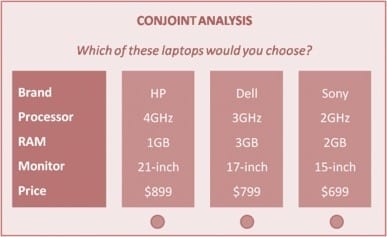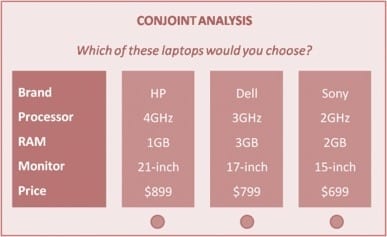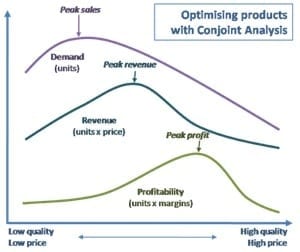
Nowadays, every business needs to appraise their products and services and decide how consumers will recognize them in order to become successful and stay in the competition, and this is achieved using conjoint analysis. It provides information regarding how consumers make their purchasing decisions and helps businesses define marketing strategies and plan product development along a number of attributes.
Conjoint analysis is also known as Discrete Choice Estimate or stated preference research. The conjoint analysis gives the information about how people choose the products and services and what they value in that product and services. The conjoint analysis presents people with choices and then analyzes their drivers of choice through a set of conjoint questions.
Since 1970s conjoint analysis and conjoint study is widely employed for product profile and services analysis. It is also used for discrete choice estimation, market share analysis and market research. This forecasting model built using conjoint design provides invaluable help to the organization which helps them in planning, experimental design and allocating resources accordingly.

This tool not only analyzes people’s choice and determine the reason behind that choice, but it also helps the managers in knowing what features they should add to their products, what impact these changes will have on sales and revenue and what impact price change will have on sales. This knowledge helps in constructing a market model and enable forecasting in different areas of business.
For example, when you purchase a house the complex purchase decisions the home buyers consider are interest rates, modern convenience, preference of location, quality of schools, modern conveniences, entertainment etc. conjoint analysis is one of the most effective models which extract consumer preferences during purchasing process into a quantitative measurement. This method evaluates products and services in the best way which is unbeatable by any other method.
The traditional rating surveys and analysis place a value on different analysis that makes a value. On the contrary conjoint analysis extrapolates the respondents’ predilection to a quantitative extent. It helps the business to mathematically analyze consumer or client behavior and make decisions which are based on real insights from the data.
The choice-based conjoint analysis is the most popular form of conjoint analysis. In this analysis, participants are shown a series of options and asked to select one thing they would like to buy from it. In the case of other conjoint analysis, people are asked to rank or rate options.
While doing conjoint analysis we assume that the products and services are broken down into various attributes. It is divided into three distinct phases
1. Data - A collection of data pertaining to trade-offs on various attributes and attribute levels. To collect the information a preliminary survey is conducted which gives the information of how the product is broken down in the consumer's mind. Then after thorough analysis and deliberations, the collected information is represented in the form of a questionnaire.
2. Analysis - After data collection, a statistical analysis of the data is done, this process derives meaning out of the result. Charts, graphs, and other tools are used to comprehensively represent information that has been collected along with its significance and interpretation. The collected result should be effectively represented since managers need to fully understand and comprehend it.
3. Action - This is the third face and in this phase, the managers use the results of the conjoint analysis and help business to arouse demand for their product and services.
Marketers are keen to know that which attribute of their products is valued by the consumers. The technique developed in the early 60s by Luce and Turkey is used to answer these questions.

Conjoint analysis is very helpful when companies remodel or revamp their products in the market. When the new version of the product is launched the questionnaire includes all possible features of attributes a company possibly adds. It helps in determining which characters to be incorporated given the imperative respondents attached to definite attributes. This also helps in ascertaining the impact it will have on costs and revenues and overall profit.
How to approach Conjoint Analysis
To give you a simple idea we will discuss the working of conjoint analysis by using three steps. Using these steps you can stimulate the conjoint analysis.
1. Designing the Conjoint or Discrete Choice Approach: The approach we outline for you depends on meeting your particular Objectives. We begin by understanding your business condition at a deep level and the decisions you confront. Then we outline a particular conjoint approach, including specialized choices, for example, the conjoint method which has to be used. The combinations of the conjoint technique and qualities will bring about the distinct data and you have to make fundamental decisions about your product and services.
2. Learning What’s Important to the Market: In order to understand the tradeoffs, some aspects are kept in mind while making a market. These aspects are the components of the Conjoint Analysis which are its features and pricing of their products and services. You can conduct a conjoint survey in which basics questions are asked which are used to determine the patterns of response and reveal accurate preferences of the consumers.
3. Developing Strategies: Based on the patterns and answers from the conjoint survey you can easily develop a simulation strategy to ask “what if” questions related to your products and services. What if we use new technology? What if we increase our price by 5%? What if we reproduce this product into lower version? What if we introduce a similar product with different pricing? This will allow you to analyze the impact of the product change via a simulation strategy.
When to use it
The following data will give the information relates to types of conjoint analysis and when to use them.
1. Menu based conjoint analysis: This conjoint analysis gives the freedom to its respondent to package their own product and services. When you have to decide pricing, product configuration, product features, building packages, or all of the above. It stimulates real-world buying situations in which respondents are asked to trade one option for another.
2. Full-profile conjoint analysis: It is very useful when we have to measure attributes utility. In this altered merchandise descriptions are developed and presented to the respondents for adequacy and predilection evaluations. It yields a great quantity of information for each customer.
3. Adaptive conjoint analysis: This analysis varies the selection set which is offered to its respondents based on their preferences. This analysis is used to yield smarter data, as it targets the customers most favored quality and levels which makes the conjoint exercise more efficiently without assassinating questions on levels with little or no appeal.
4. Choice-based conjoint analysis: It is also known as discrete-choice conjoint analysis. When the respondents have to choose from the most preferred full-profile concept then this analysis is useful. It stimulates and actual retail situations, which imitate actual shopping, conduct. The output of choice-based conjoint analysis gives you an estimate of the important features in regards to pricing.
5. Self-explicated conjoint analysis: Using this analysis you need not develop full profile concepts as it provides you with a robust approach that is easy to implement. It directs ask the features and each feature is represented separately for evaluation or elimination.


